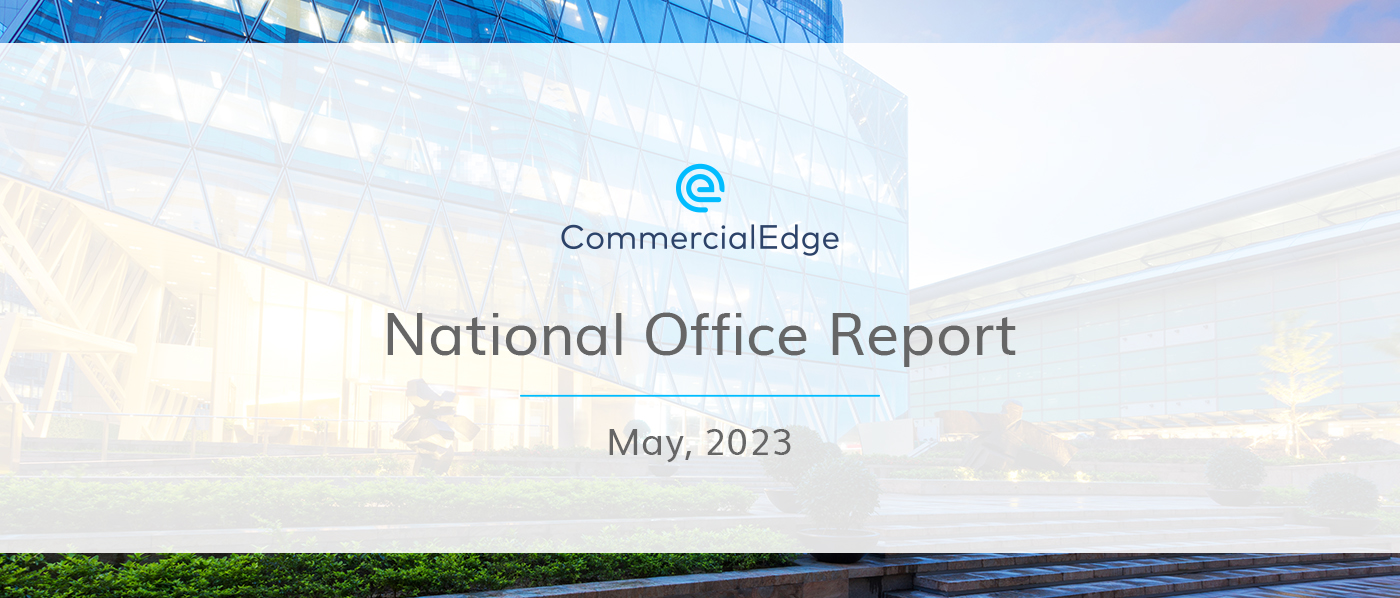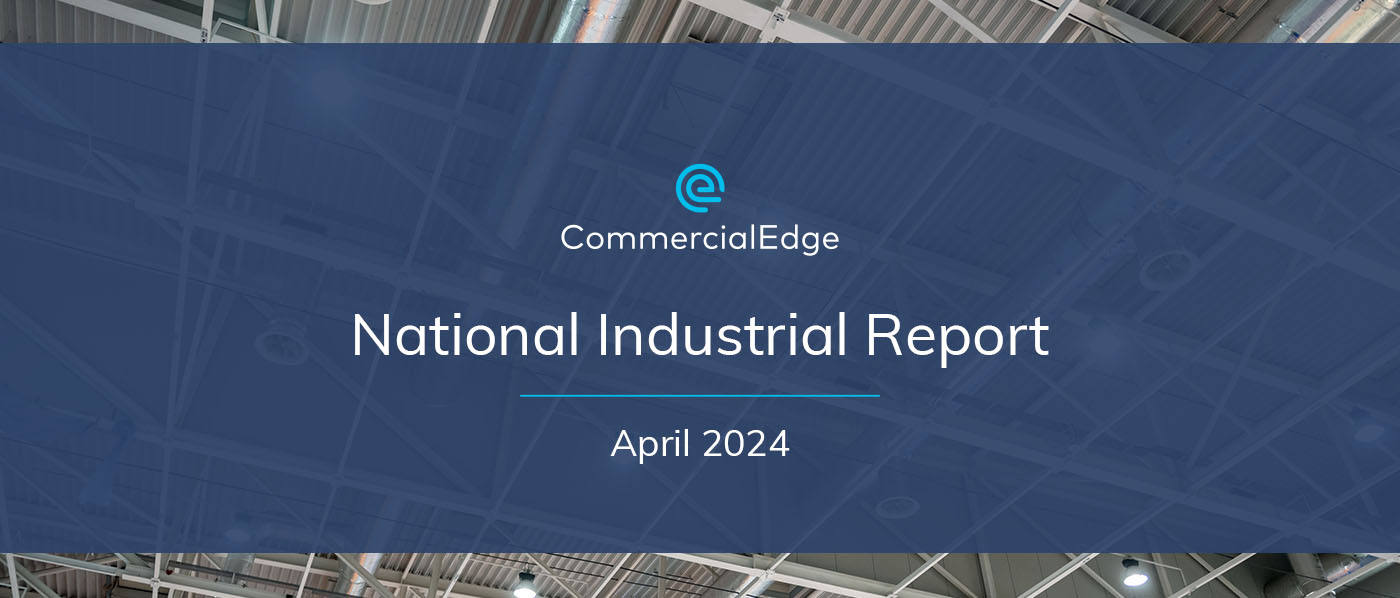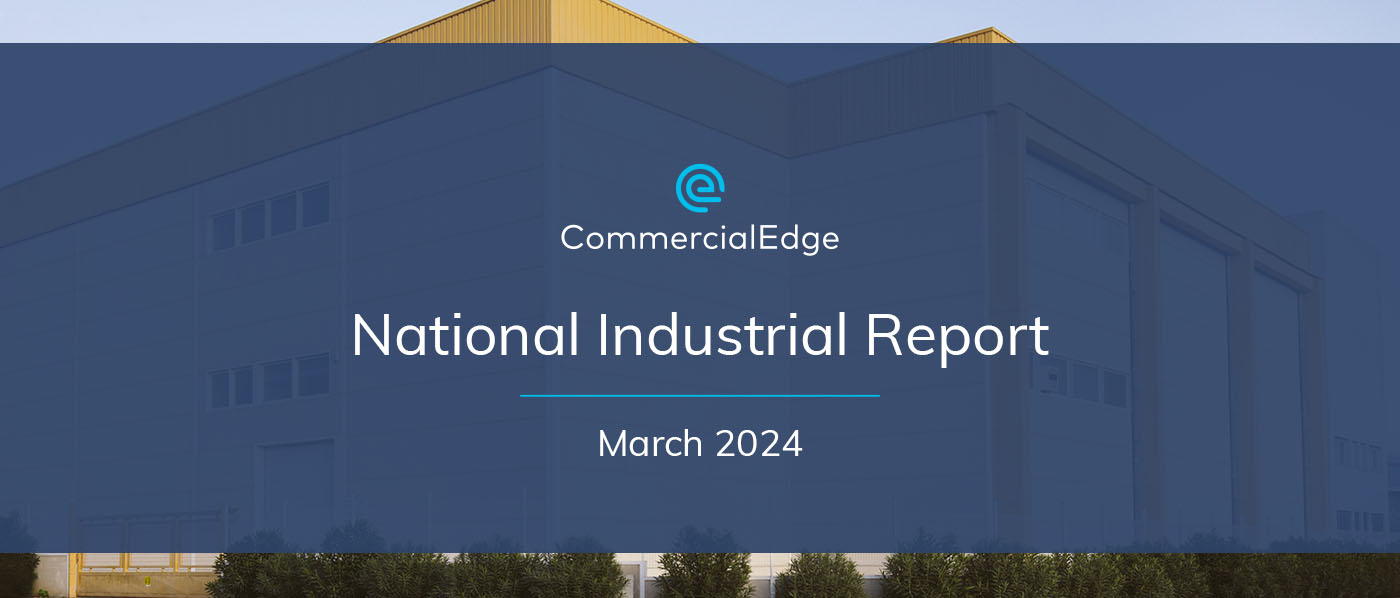Key Takeaways:
- The average U.S. office listing rate stood at $38.23 per square foot, rising 2.3% year-over-year
- Up 100 basis points year-over-year, the national vacancy rate was 16.7%
- Under-construction office space reached 118.2 million square feet nationwide, accounting for 1.8% of the total stock
- Office sales amounted to $9.4 billion in April, with assets trading at $196 per square foot
- Challenges in the tech sector continued to push vacancy rates higher, with Denver reaching 19.94%
- At $27.92 per square foot, Chicago asking rents were $10.31 lower than the national average
- Austin led the nation in development on a percentage-of-stock basis, with underway projects representing 6.7% of its existing inventory
- Manhattan recorded the largest sales volume in the U.S., with investors closing on $858 million in the first four months of the year
In an economic landscape full of challenges, the future of the U.S. office sector continues to be unsettled. Although office-using sectors added 67,000 jobs in April for a 2% year-over-year increase, the demand for office space remained weak across major markets, our latest office market report reveals.
The national U.S. office vacancy rate reached 16.7%, rising 100 basis points over year-ago figures. Tech layoffs and a large share of office tenants trimming their office occupancies continue to put pressure on some of the most established office markets in the country.
As tech firms push to “right-size” their businesses, they’re putting further pressure on availabilities by adding sublease space to the market. Big Tech was the leader in committing to office deals during COVID, but occupancy still has not materialized for much of that space. The societal relationship with office space continues to fundamentally change.
Peter Kolaczynski, CommercialEdge Senior Manager
Metros once driven by a thriving tech industry are now disproportionately impacted by the pullback of tech firms. For example, Austin saw its vacancy rates climb 5.86% year-over-year in April, while other tech hubs such as Seattle and Denver experienced 3.28% and 2.45% upticks over the same period.
Weakening demand, coupled with repeated interest rate hikes and increased market volatility driven by the recent failures of Silicon Valley Bank, Signature Bank and Credit Suisse are expected to further drive uncertainty and put downward pressure on sales.
Listing Rates and Vacancy: The National Office Vacancy Rate Continues to Rise
The national average full-service equivalent listing rate was $38.23 in April, the newest U.S. office market report reveals, increasing 2.3% over the past 12 months. Listing rates across A and A+ office spaces stood at $46.89 per square foot, up 2.4% over year-ago figures. Meanwhile, Class B office rates fell 0.2% to $30.26 per square foot and rates for Class C spaces decreased 1.1% to $22.80 year-over-year in April.
Top Listings by Metro Area: April 2023
Location-wise, suburban assets remained in the lead for rent increases, rising 4.2% year-over-year to $30.96 per square foot, followed by CBD offices at $51.06 after a year-over-year increase of 3.7%. Urban office space remained on a downward trend, decreasing 3.2% year-over-year to $44.02.
The U.S. national vacancy rate in April was 16.7%, up 10 basis points over the previous month and 100 basis points higher than year-ago figures. Office occupancy rates continued to be the lowest within CBDs, where vacant spaces accounted for 18.1% of stock in April. At the same time, urban (16.1%) and suburban (16.5%) office assets registered vacancy rates below the national average.
Nationwide, Austin registered the sharpest vacancy rate increase, climbing to 22.03%. The declining office occupancy rate in the metro is likely also fueled by the woes of the tech sector. San Francisco, another tech-driven market, also saw its vacancy rise to 19.41% in April, the fifth-highest rate across the country.
Supply: Demographics Fuel Florida’s Medical Office Space
Nationally, 118.2 million square feet of office space was under construction as of April, representing 1.8% of the total stock. Class A and A+ properties accounted for most of the supply, with 109.9 million square feet of these asset types in the pipeline. In addition, more than 300 million square feet were in the planning stages.
Office Space Under Construction (Million Sq. Ft)
While the future of demand is evolving in much of the office industry, the medical office sector offers a stronger outlook for long-term demand, driven in part by the needs of an aging population. As a result, medical offices continue to attract developer interest, especially in areas with favorable demographics.
In Florida, where 21% of the population is over the age of 65, medical office construction is robust: More than 1.9 million square feet of properties currently under construction will include medical office space. The largest of these projects is the UHealth Medical Center at SoLé Mia; the 363,000-square-foot medical hub broke ground in North Miami last year.
Transactions: Large Deals Have Greater Impact in 2023
The U.S. office market has seen $9.4 billion in transactions year-to-date through April, with buildings trading at an average of $196 per foot. National office real estate outlooks anticipate that sales will continue to slow in 2023 as CRE professionals adjust to higher interest rates and the frosty capital markets.
2023 Year-to-Date Sales (Millions)
With the slowdown in sales, large office deals are having a more pronounced influence on sales volumes in 2023. New Jersey, for example, has been the second-most active market so far this year with $807 million in closed office deals. However, that figure was mainly driven by one transaction: Veris Residential sold the Harborside Financial Center Plaza, a three-office building complex of 1.9 million square feet in Jersey City.
Western Markets: Tech Sector Headwinds Continue to Pressure Major Hubs in the West
Western markets continued to face headwinds associated with the tech-driven economy, putting upward pressure on vacancy rates in most markets in the region. In April, Denver’s vacancy rate stood at 19.94%, rising 2.45% year-over-year, the highest rate in the region and the third highest nationwide.
San Francisco also continued to experience rate hikes as prominent corporate tech tenants, such as Salesforce or Meta, listed their space for sublease as they plan to downsize or vacate offices. The flood of sublease space to the office market has pushed up the vacancy rate. San Francisco’s vacancy rate in April rose to 19.4%, up 1.96% over the previous 12 months. The sharpest increases in office vacancy rates by city, however, were recorded in Portland and Seattle, up 3.54% and 3.28%, respectively.
San Francisco Vacancy Rate
Despite headwinds, San Francisco remained the priciest market in the West, with asking rents at $65.37 per square foot, followed by the Bay Area at an average of $55.08 per square foot. Manhattan was the only market to exceed the two Northern California asking rates in the entire U.S., with the average rent at $74.02 per square foot. At the same time, the lowest listing rates in the West were recorded in Phoenix ($27.33 per square foot) and Portland ($29.39 per square foot), below the $38.23 national average.
While the national supply pipeline is expected to continue shrinking in the near future, developers in the West remained comparatively active. On a percentage-of-stock basis, San Diego led construction with 4.9 million square feet of office space underway, equal to 5.3% of the local stock.
Meanwhile, San Francisco’s 7.9 million-square-foot pipeline accounted for 5.1% of existing inventory, and Seattle’s nearly 6.9 million-square-foot space underway represented 5% of the local inventory. In Portland, however, there were only 565,714 square feet of office space underway, equal to just 1% of existing inventory.
West Regional Highlights
In terms of sales volume, Los Angeles led the West, with a total of $629 million in closed office deals at an average price of $251 per square foot. The next largest sales volume was recorded in San Francisco, where a total of $316 million worth of office space changed hands. Nonetheless, office space in San Francisco traded at an average sale price of $520 per square foot, the largest price in the region and the second largest nationwide, after Manhattan’s $699 per square foot. Overall, all Western markets recorded sale prices above the $196 national average, with Phoenix’s $237 per square foot and Denver’s $244 per square foot the lowest in the region.
Midwestern Markets: Chicago and the Twin Cities Continue to Record Asking Rents Below the National Average
Conditions in the Midwest’s major office markets haven’t improved significantly during the first four months of the year, with key fundamentals remaining mostly stagnant. In April, asking rents in Chicago stood at $27.92 per square foot, $10.31 below the national rate.
Meanwhile, Minneapolis – St. Paul closed April at $26.96 per square foot. These listing rates continued to rank among the five lowest in the country, along with Tampa’s $27.90 per square foot, Phoenix’s $27.33 per square foot and Orlando’s $24.62 per square foot.
Midwest Regional Highlights
The office occupancy rate in Chicago was mostly in line with other major office markets in the U.S. The market’s vacancy rate of 18.8% came in just slightly below San Francisco’s 19.41%, Brooklyn’s 19.39% and Seattle’s 19.02%. Chicago’s Fulton Market, however, has defied market conditions seen in the rest of the city, according to the Chicago Business Journal. Thanks to the life sciences and biotech sectors, as well as the new Class A buildings in the area, the submarket saw higher rents and lower vacancy rates compared to the rest of the metro.
At the same time, with recent incentives in Chicago to encourage office-to-apartment conversions, the new supply pipeline remained moderate in the metro. As of April, the Windy City had 3.7 million square feet of office space under construction, accounting for merely 1.2% of its existing stock. Developers also remained wary of adding new supply to the Twin Cities — the metro had just 546,369 square feet underway, equal to 0.5%. The metro also had the lowest pipeline among the nation’s top 25 markets, both in terms of square footage and on a percentage-of-stock basis.
Office Space Under Construction & Planned (% of stock)
In the first four months of the year, investors traded a total of $435 million in the Midwest’s leading office markets. In Chicago, a total of $354 million sold, with offices changing hands at $91 per square foot — the lowest price among leading office markets. Meanwhile, the Twin Cities saw a mere $81 million in closed office deals, albeit at an average price of $203 per square foot.
Southern Markets: Office Occupancy Rates Drop in Austin Amid Tech Pullback
With Texas leading the nation in the back-to-office movement as well as continued migration and business relocation trends, Austin has become one of the fastest-growing office markets in the past few years. And developers responded to Austin’s growth: Last year alone, the metro saw more than 3 million square feet of new office space delivered, a previous CommercialEdge U.S. office market report revealed.
Austin has also led the nation in development over the past several months. As of April, the metro had 5.9 million square feet of office space under construction, accounting for 6.7% of its stock — the largest pipeline on a percentage-of-stock basis among the nation’s top 25 office markets.
South Regional Highlights
However, Austin’s vacancy rate recorded a 5.86% uptick year-over-year in April, reaching 22.03%. This was the highest vacancy rate registered in the South, outpacing Houston’s 21.51% and Atlanta’s 19.7% rate. As Austin’s boom has been fueled by tech companies relocating from established California hubs, the tech pullback might be affecting the metro’s office market.
The Texas capital, however, remained the second priciest market in the South, with asking rents at $41.41 per square foot, coming in after Miami’s $46.60 per square foot. Nonetheless, both markets saw asking rents decrease year-over-year in April, with rates falling 2.59% in Austin and 2.63% in Miami.
Among Southern markets, Washington, D.C., was the only other market with asking rents above the $38.23 national average, stabilizing at $40.37 per square foot. Meanwhile, the lowest rates were recorded in Tampa ($27.90 per square foot) and Orlando ($24.62 per square foot).
In terms of sales volume, Washington, D.C., and Houston led the South, with a total of $509 million and $466 million in closed office deals, respectively. The highest sale prices, however, were recorded in Austin ($389 per square foot), Dallas ($294 per square foot) and Miami ($261 per square foot).
Northeastern Markets: Manhattan, New Jersey and Boston Claim Top 3 Largest Sales Volumes in the U.S.
Office markets in the Northeast took the lead in sales in the first four months of the year, with Manhattan, New Jersey and Boston registering the top three largest sales volumes nationwide, recording $858 million, $807 million and $721 million, respectively. Philadelphia lagged in the region, with a total of $294 million in closed office deals.
However, as sales velocity has slowed, most of the activity in these markets is being driven by single-asset purchases. For example, Manhattan’s volume was boosted by Hyundai’s $275 million acquisition of an office building in the Tribeca neighborhood. Meanwhile, New Jersey’s sales volume was bolstered by Veris Residential’s sale of three office buildings in Jersey City.
Northeast Regional Highlights
Manhattan remained the most expensive market for office rents in April, closing the month at an average rate of $74.02 per square foot. In fact, Manhattan's asking rates were $8.65 higher than the next priciest rate, San Francisco’s $65.37, and nearly $19 higher compared to the third-highest average asking rent of $55.08 in the Bay Area.
At the same time, the vacancy rate in Manhattan stood at 16.77% in April, below the 19.39% recorded in Brooklyn, and slightly above New Jersey’s 16.61% vacancy. To boost Manhattan’s office market, the NYC Economic Development Corp., in partnership with the NYC Industrial Development Agency, has unveiled a plan to provide tax incentives for office building renovation in order to increase quality, occupancy and commercial traffic, Commercial Property Executive reported.
Manhattan also had a generous office construction pipeline, with some 9.5 million square feet of space underway, accounting for 2.1% of existing stock. However, Boston led development in the Northeast, with 14.8 million square feet under construction, equal to 6.1% of existing inventory. In terms of square footage, Boston also had the largest pipeline among the nation’s top 25 markets. Brooklyn stood at the other end of the spectrum with 1.5 million square feet underway, equal to 4.1% of existing stock.
Office-Using Employment: Healthier Office Job Growth in April
Office-using sectors of the labor market added 67,000 jobs in the month of April and have grown 2% year-over-year. Compared to the average monthly gain of 27,000 jobs over the prior six months, office-using employment had healthy growth last month.
Office-Using Employment Growth by Sector
The increase in office-using employment growth in April was boosted by hiring in the financial activities industry. Employment in financial activities increased by 23,000, with strong job gains in insurance carriers and related activities (+15,000) and in real estate (+9,000).
The gain for financial activities jobs erased the 1,000 jobs lost in the previous month. Professional and business services (PBS) also helped this acceleration in office-using employment. In April, PBS employment continued to trend upwards, gaining 43,000 jobs.
Trends & Industry News: Demand for Flex Space Continues to Rise
The office landscape continues to evolve after the pandemic fundamentally altered how people interact with the workplace. Amid the disruption, there continue to be opportunities in the office sector, including flexible space. Coworking is experiencing a resurgence due to the flexibility it offers tenants and the widespread adoption of hybrid work strategies.
With this increase in demand, flexible office providers have seen their occupancy rates improve steadily since late 2020, even approaching pre-pandemic levels in 2022, according to a report by JLL.
WeWork, for example, reported another quarter-over-quarter rise in occupancy in its 2023 first-quarter results. This strong demand for coworking is expected to accelerate in the coming years. The global coworking industry is expected to grow at a rate of 17% annually to more than $30 billion in 2026, according to a report from The Business Research Company, a market research and intelligence firm.
Across the nation, there are roughly 5,600 shared office space locations totaling more than 115 million square feet, according to CommercialEdge. Shared space has an overall market penetration of 1.7% of office space. The majority of the country’s coworking locations are concentrated within the top markets, which account for more than half of the locations.
Manhattan has the highest volume of flexible space, with 13.8 million square feet across 291 locations, representing 2.8% of stock. In Brooklyn, flexible space has a market penetration of 5.7% of office space, despite the total square footage being small relative to other top markets (1 million square feet).
Several other gateway markets also have a large presence of coworking, including Washington, D.C. (6.5 million square feet, 1.7% of stock), Los Angeles (6.5 million square feet, 2.2% of stock) and Chicago (6.2 million square feet, 1.9% of stock). While overall market penetration is relatively small compared to other office niches in most markets, the presence of flexible space is anticipated to continue to grow to meet increasing demand.
Outside of the top players, Regus, WeWork and Industrious, there are over 2,000 traditional coworking operators nationwide. A growing number of building owners have also recognized the potential of flexible office space and have started offering their own flex space as solutions for vacant inventory.
Download the PDF report to view more, including the map for office-using employment growth.

You can also see our previous office reports.
Methodology
This report covers office buildings 25,000 square feet and above. CommercialEdge subscribers have access to more than 14,000,000 property records and 300,000 listings for a continually growing list of markets.
CommercialEdge collects listing rate and occupancy data using proprietary methods.
Listing Rates — Listing Rates are full-service rates or “full-service equivalent” for spaces that were available as of the report period. CommercialEdge uses aggregated and anonymized expense data to create full-service equivalent rates from triple-net and modified gross listings. Expense data is available to CommercialEdge subscribers. National average listing rate is for the top 50 markets covered by CommercialEdge.
Vacancy — The total square feet vacant in a market, including subleases, divided by the total square feet of office space in that market. Owner-occupied buildings are not included in vacancy calculations.
A and A+/Trophy buildings have been combined for reporting purposes.
Stage of the supply pipeline:
Planned — Buildings that are currently in the process of acquiring zoning approval and permits but have not yet begun construction.
Under Construction — Buildings for which construction and excavation has begun.
Office-Using Employment is defined by the Bureau of Labor Statistics as including the sectors Information, Financial Activities, and Professional and Business Services. Employment numbers are representative of the Metropolitan Statistical Area and do not necessarily align exactly with CommercialEdge market boundaries.
Sales volume and price-per-square-foot calculations for portfolio transactions or those with unpublished dollar values are estimated using sales comps based on similar sales in the market and submarket, use type, location and asset ratings, sale date and property size.
Year-to-date metrics and data include the time period between January 1 of the current year through the month prior to publishing the report.
Market boundaries in the CommercialEdge office report coincide with the ones defined by the CommercialEdge Markets Map and may differ from regional boundaries defined by other sources.
Stay current with the latest market reports and CRE news
Latest Posts
Recent Reports
Historic Levels of New Supply Push Industrial Vacancy Rates Higher in Q1 2024
The U.S. industrial vacancy rate was 5.2% in March, up 20 basis points from the previous month.
Q1 2024 Office Sales Dip to $5.4 Billion, 17% Below Last Year’s Figure
Office sales continued to wane in Q1 2024 as companies embraced remote and hybrid work and re-examined their office footprints.
Industrial Sale Prices Hold Firm Amid Normalizing Demand and Shifting Capital Markets
Despite the decline in sales over recent quarters, the average sale price of industrial properties has remained high, increasing by 9.6% quarter-over-quarter and 2.0% year-over-year.






